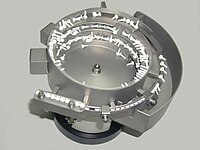
Photo from wikipedia
Abstract Screw feeder performance is a critical aspect in continuous manufacturing processes. Pharmaceutical excipients, such as mannitol, microcrystalline cellulose, lactose monohydrate, and anhydrous dibasic calcium phosphate can present problems in… Click to show full abstract
Abstract Screw feeder performance is a critical aspect in continuous manufacturing processes. Pharmaceutical excipients, such as mannitol, microcrystalline cellulose, lactose monohydrate, and anhydrous dibasic calcium phosphate can present problems in ensuring a continuous stable feed rate due to their sub-optimal flow properties. In alignment with Quality by Design (QbD) goals, the aim of this work was to identify and explain critical sources of variability of some powder excipients delivery by screw feeding, in particular to continuous processing lines. Pharmaceutical excipients with a wide range of material properties were selected, and the impact of their flow and density properties on screw feeder performance was investigated. The analysis of the powder conveying by the screws was performed at different hopper fills and different screw speeds. A multivariable model involving bulk density (CBD) and parameters from FT4 dynamic downwards testing (SI) and dynamic upwards testing (SE) explained 95.7% of excipients feed rates (p < .001). The study gathers valuable information about the screw feeder performance and input materials properties that can help process understanding and QbD-based development of solid dosage forms in continuous processing lines.
Journal Title: Drug Development and Industrial Pharmacy
Year Published: 2018
Link to full text (if available)
Share on Social Media: Sign Up to like & get
recommendations!